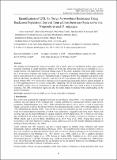| dc.contributor.author | Evans Atuti Atera, John Collins Onyango, Pham Thien Thanh, Takashige Ishii, Kazuyuki Itoh | |
| dc.date.accessioned | 2020-08-12T11:00:14Z | |
| dc.date.available | 2020-08-12T11:00:14Z | |
| dc.date.issued | 2015-02-01 | |
| dc.identifier.citation | 2 | en_US |
| dc.identifier.issn | 1916-9752 | |
| dc.identifier.issn | 1916-976 | |
| dc.identifier.uri | https://repository.maseno.ac.ke/handle/123456789/2050 | |
| dc.description.abstract | The obligate root hemiparasite, Striga hermonthica (Del.) Benth., native to sub-Saharan Africa causes serious
economic constraint to cereal production. Studies on Striga spp. interactions with rice are desirable as it is a
model monocot with high density molecular linkage maps. In this study, quantitative trait locus (QTL) analysis
for S. hermonthica resistance was carried out using 141 backcross recombinant inbreed lines (BRILs) derived
from a cross between Oryza sativa (cv. Nipponbare) and O. rufipogon W630. The population was grown in the
field at Lake Basin Development Authority, Alupe farm in 2013 and infected with S. hermonthica from Alupe,
Kenya. Putative QTL for S. hermonthica resistance was assumed using single-point analysis (qGene program) at
p < 0.01 significance level. As a result, a single QTL explaining 6.6% of total phenotypic variance was detected
near RM242 marker locus on chromosome 9, and the Nipponbare allele was found to have S. hermonthica
resistance. The QTL chromosomal region can also be further studied to promote better understanding on the
nature of resistance. | en_US |
| dc.publisher | Canadian Center of Science and Education | en_US |
| dc.subject | quantitative trait loci (QTLs), rice, Striga hermonthica, resistance | en_US |
| dc.title | Identification of QTL for Striga hermonthica Resistance Using Backcross Population Derived from a Cross between Oryza sativa (cv. Nipponbare) and O. rufipogon | en_US |
| dc.type | Article | en_US |

